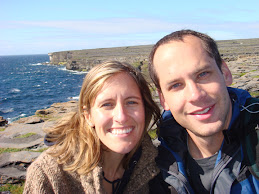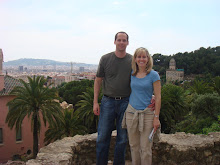
The Rock of Cashel, with its well preserved ecclesiastical remains, is one of Ireland's spectacular landmarks, rising high above the surrounding plain on a hill of limestone (i.e. "the rock"). History at Cashel is only documented back to the 4th century, but St. Patrick converted the local King Aenghus here in the 5th century. The Rock served as the traditional seat of the Kings of Munster, one of the four provinces of Ireland, whose kingdom stretched over much of Ireland's south and southwest. Its greatest king later became the High King of Ireland, Brian Boru - prior to the Norman invasion.
In 1101, Cashel was handed over to the church where it flourished as a religious center until it was laid seiged to by Oliver Cromwell's army's in 1647. This resulted in the deaths of more than 3,000 people.
I read online that the Rock was one of the film sets for the movie "Excalibur."
The site includes several structures built with different architectural styles; highlights include:
- Cormac's Chapel, a Romanesque church (the "Jewel of Cashel," circa 1134)
- A Gothic cathedral (built between 1235 and 1270)
- A traditional Irish round tower (90 feet high; circa 1100)
- A tower house
- Hall of the Vicars' Choral (built in the 15th century)
- St Patrick's High Cross (circa 12th century)
Our tour guide said that all the buildings were built from limestone from the surrounding hills. Inside the Cormac's Chapel is a sarcophagus that probably contained the remains of either a king or a Cashel priest at one time. The original sits in the National Museum in Dublin on Kildare Street. The chapel entrance features a wonderful Romanesque archway with supports.
The cathedral is the largest building on the site. Within the walls of this grand structure are many interesting features: several carved tombs in the North Transept with remarkably detailed, well-preserved carvings despite exposure to the elements; stone hooks on the walls where a wooden balcony would have housed the vicars choral during mass; tomb of Miler Magrath, who caused a scandal by being both a Protestant and Catholic archibishop at the same time (he lived to be 100); and The Crossing, a lovely detailed arch where the four sections of the building come together.
The Round Tower is the oldest and tallest building on the site. Round towers were known as both a storage place for valuables and a lookout for advancing intruders. The doorway is about 10 feet from the ground. Cashel priests and students would climb a ladder and up into the many levels of stairs to fill the tower, then the ladder was raised up inside, according to several sources. Our guide also said that further research has questioned the true reason why the doorway is 10 feet off the ground. It probably was most likely because round towers were built back then without cement (just stacked stones), so it was critical that the base of the tower be the strongest point. Having a door at the base would have weakened the structure.
The original Saint Patrick's Cross now sits inside the dormitory museum onsite. St. Patrick was said to have visited Cashel in 450 AD, and the cross was erected in his honor. The east side of the cross shows the image of St. Patrick carved into its surface.
Although Cashel looks like a monastic site with all its various buildings housed inside a wall, only the archibishop, his aides and the vicars choral resided here, according to our tour guide. (There are ruins of Dominic's Abbey and Hore Abbey nearby, which we do not visit on this trip.)
The vicars choral were laymen appointed to assist in chanting the cathedral services. At Cashel there were originally eight vicars choral with their own seal. The restoration of the Hall of Vicars' Choral was undertaken by the Office of Public Works as a project in connection with the European Architectural Heritage Year (1975). Along with the dormitory block, is now home to the visitors center and museum.
There is also the O'Scully's Monument near the corner of the outer wall of the Rock of Cashel, an ornate memorial erected in 1870 by a local landowning family. Brú Ború, a national cultural centre, is located at the foot of the Rock of Cashel, but we didn't pay a visit.
On our way out to Cashel, we made a quick stop in Nenagh, the bustling provincial town owes its origins to the Norman Butlers who build a castle here in 1220. We snapped a few shots of the castel ruins, which are being restored, as well as St. Mary's Church of the Rosary, a neo-gothic church, built 1896 and noted for its stained glass windows from the famous Harry Clarke studio. We also drove past the nearby are the remains of a medieval Franciscan Abbey.




No comments:
Post a Comment